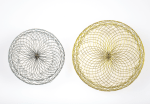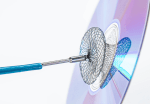The octogenarian population has already reached 137 million and continues to grow. It is estimated to triple by 2050. This increase represents a big challenge, seeing as these patients are often more fragile, present more complex coronary artery disease and multiple comorbidities. This generally requires two or more procedures and more experience both from operators...
Antiplatelet Treatment with Ticagrelor vs. Clopidogrel in Patients with Chronic Coronary Syndrome
Achieving rapid and maximum inhibition of platelet aggregation can reduce complications related to scheduled percutaneous coronary intervention (PCI) in chronic coronary syndromes (CCS). Over the last few decades, the optimal timing for initiating P2Y12 inhibitors and their appropriate dosage have been the subject of numerous studies; however, they have not been clearly established yet. Higher...
Coronary Angioplasty with Sirolimus Eluting Stents
At present, most percutaneous coronary intervention procedures (PCI) are done with drug eluting stents (DES). However, drug coated balloons (DCB) have shown benefits in restenosis and small vessel de novo lesions. Intravascular ultrasound (IVUS) has been shown effective in left main PCI and complex procedures, even though there is little infomration on its use for...
EuroPCR 2024 | NOTION-2: TAVI vs SAVR, Randomized Study on Low-Risk Young Patients with Severe Tricuspid Disease or Bicuspid Stenosis
Many of the studies comparing TAVR against SAVR in low risk patients included patients between 70-75 years, excluding those with tricuspid valves. This study included low surgical risk patients with severe aortic stenosis and symptoms, 75 years or younger. Participants were randomized 1:1 to receiving TAVR or SAVR, stratified according to sex, need for new...
Catheter-Based Therapy for Pulmonary Embolism: Lower Mortality and Rehospitalization?
Venous thromboembolism represents one of the main causes of cardiovascular death. Pulmonary embolism (PE) can vary from asymptomatic to manifesting with shock and sudden death, with a wide clinical spectrum. Patient followup is crucial, seeing as survival PE patients usually experience residual symptoms at long term, such as dyspnea or functional capacity deterioration. For decades,...
Evolution of Leak in Left Atrial Appendage Closure
Atrial fibrillation is common in elderly people and is associated with a higher risk of ischemic stroke. Left atrial appendage occlusion (LAAO) is a valid strategy, especially in patients at high risk of bleeding. The presence of peridevice leak (PDL) has been linked to stroke, although some analyses, such as the PROTEC-AF Study, suggest that...
Acute Myocardial Infarction After TAVI: Retrospective Analysis of >200,000 Implants
Coronary artery disease is common among patients considered for transcatheter aortic valve implantation (TAVI). With the expansion of the indication for TAVI to a population with lower surgical risk, and therefore younger, there has been a gradual increase in the incidence of coronary events. However, there is limited data on treatment strategy and outcomes in...
12-Month Evolution of Edge-to-Edge Repair with PASCAL
Mitral regurgitation (MR) is the most frequent valve disease. Mitral transcatheter edge-to-edge repair (M-TEER) has been shown beneficial in high or prohibitive risk patients in cases of degenerative and functional MR. The PASCAL device has been shown safe and effective by the CLASP II, but we still need further research in clinical “real world” environments. ...
Single Antiplatelet Therapy Following Percutaneous Left Atrial Appendage Occlusion
Percutaneous left atrial appendage occlusion (LAAO) has surged as an effective alternative to treat patients with atrial fibrillation (AF) presenting counterindications for oral anticoagulants. However, the optimal antithrombotic treatment after LAAO is still debated, seeing as it should prevent device related thrombosis (DRT) while minimizing bleeding risk. The aim of this retrospective study carried out...
Peripheral Vascular Disease: Our Reality in Latin America, with the LATAM SOLACI Peripheral Registry
On the one hand, chronic peripheral vascular disease is on the rise. On the other, over the past 20 years, percutaneous coronary intervention (PCI) has gained considerable ground thanks to various new devices, replacing surgery as an alternative in most scenarios. Both strategies have shown similar results, but PCI has fewer complications and shorter hospital stays....









